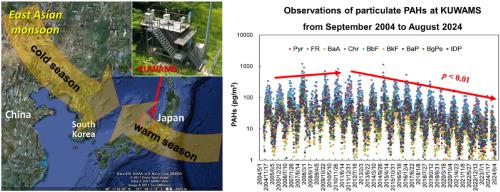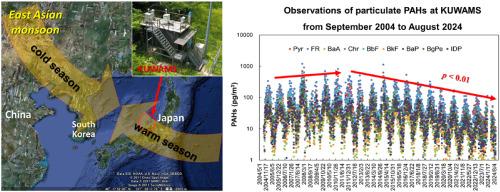日本一个背景地点季风驱动的运输和多环芳烃来源特征的二十年研究
IF 7.3
2区 环境科学与生态学
Q1 ENVIRONMENTAL SCIENCES
引用次数: 0
摘要
东亚季风条件下粒子结合的多环芳烃(PAHs)的远距离迁移对区域空气质量管理提出了重大挑战,但人类活动如何影响PAHs时空动态的研究仍然有限。通过2004-2024年东亚季风区某背景站点20年的监测,采用逆向轨迹和正矩阵分解模型分析了颗粒物多环芳烃的时空变化及其来源。多环芳烃平均浓度(426.1±399.5 pg/m3)反映了区域大气背景值,表现出明显的冬季最大值和夏季最小值特征。这种季节性主要是由季风介导的来自东亚热点地区的污染羽流运输驱动的。煤炭燃烧(CC; 41.1%)和车辆排放(VE; 29.9%)是主要的排放源,并呈现出相反的季节模式:在东亚冬季风驱动的大陆外流驱动下,CC的贡献在冬季达到峰值,而VE的贡献在夏季月份占主导地位,这与东亚夏季风加强输送日本排放有关。2012年至2024年期间,多环芳烃浓度的显著降低追踪了东亚地区由政策驱动的CC和VE贡献的下降。然而,生物质燃烧和非道路移动机械以及焦化排放对多环芳烃的贡献强调了尚未解决的区域挑战。这项工作证明了区域空气质量治理在减轻跨界多环芳烃污染方面的累积效益,为优化东亚多国减排战略提供了基准数据集和重要见解。本文章由计算机程序翻译,如有差异,请以英文原文为准。


Two-decade study of monsoon-driven transport and source signatures of polycyclic aromatic hydrocarbons at a Japanese background site
Long-range transport of particle-bound polycyclic aromatic hydrocarbons (PAHs) under the East Asian monsoon regime poses significant challenges to regional air quality management, yet research on how human activities influence the spatiotemporal dynamics of PAHs remains limited. Through 20 years (2004–2024) of monitoring at a background site within the East Asian monsoon region, this study analyzed the temporal variations of particulate PAHs and their sources using backward trajectory and positive matrix factorization models. The mean PAHs concentration (426.1 ± 399.5 pg/m3) reflected regional atmospheric background values, exhibiting distinct characteristics of winter maxima and summer minima. This seasonality was driven primarily by monsoon-mediated transport of pollution plumes from East Asian hotspots. Coal combustion (CC; 41.1 %) and vehicle emissions (VE; 29.9 %) emerged as dominant sources, displaying inverse seasonal patterns: CC contributions peaked during winter under continental outflow driven by the East Asian Winter Monsoon, while VE dominated summer months coinciding with strengthened East Asian Summer Monsoon transporting Japanese emissions. Significant reductions in PAHs concentration between 2012 and 2024 tracked policy-driven declines in CC and VE contributions across East Asia. Nevertheless, contributions of biomass burning and non-road mobile machinery and coking emissions to PAHs underscore unresolved regional challenges. This work demonstrates the cumulative benefits of regional air quality governance in mitigating transboundary PAHs pollution, delivering a benchmark dataset and important insight for optimizing multinational mitigation strategies in East Asia.
求助全文
通过发布文献求助,成功后即可免费获取论文全文。
去求助
来源期刊

Environmental Pollution
环境科学-环境科学
CiteScore
16.00
自引率
6.70%
发文量
2082
审稿时长
2.9 months
期刊介绍:
Environmental Pollution is an international peer-reviewed journal that publishes high-quality research papers and review articles covering all aspects of environmental pollution and its impacts on ecosystems and human health.
Subject areas include, but are not limited to:
• Sources and occurrences of pollutants that are clearly defined and measured in environmental compartments, food and food-related items, and human bodies;
• Interlinks between contaminant exposure and biological, ecological, and human health effects, including those of climate change;
• Contaminants of emerging concerns (including but not limited to antibiotic resistant microorganisms or genes, microplastics/nanoplastics, electronic wastes, light, and noise) and/or their biological, ecological, or human health effects;
• Laboratory and field studies on the remediation/mitigation of environmental pollution via new techniques and with clear links to biological, ecological, or human health effects;
• Modeling of pollution processes, patterns, or trends that is of clear environmental and/or human health interest;
• New techniques that measure and examine environmental occurrences, transport, behavior, and effects of pollutants within the environment or the laboratory, provided that they can be clearly used to address problems within regional or global environmental compartments.
 求助内容:
求助内容: 应助结果提醒方式:
应助结果提醒方式:


